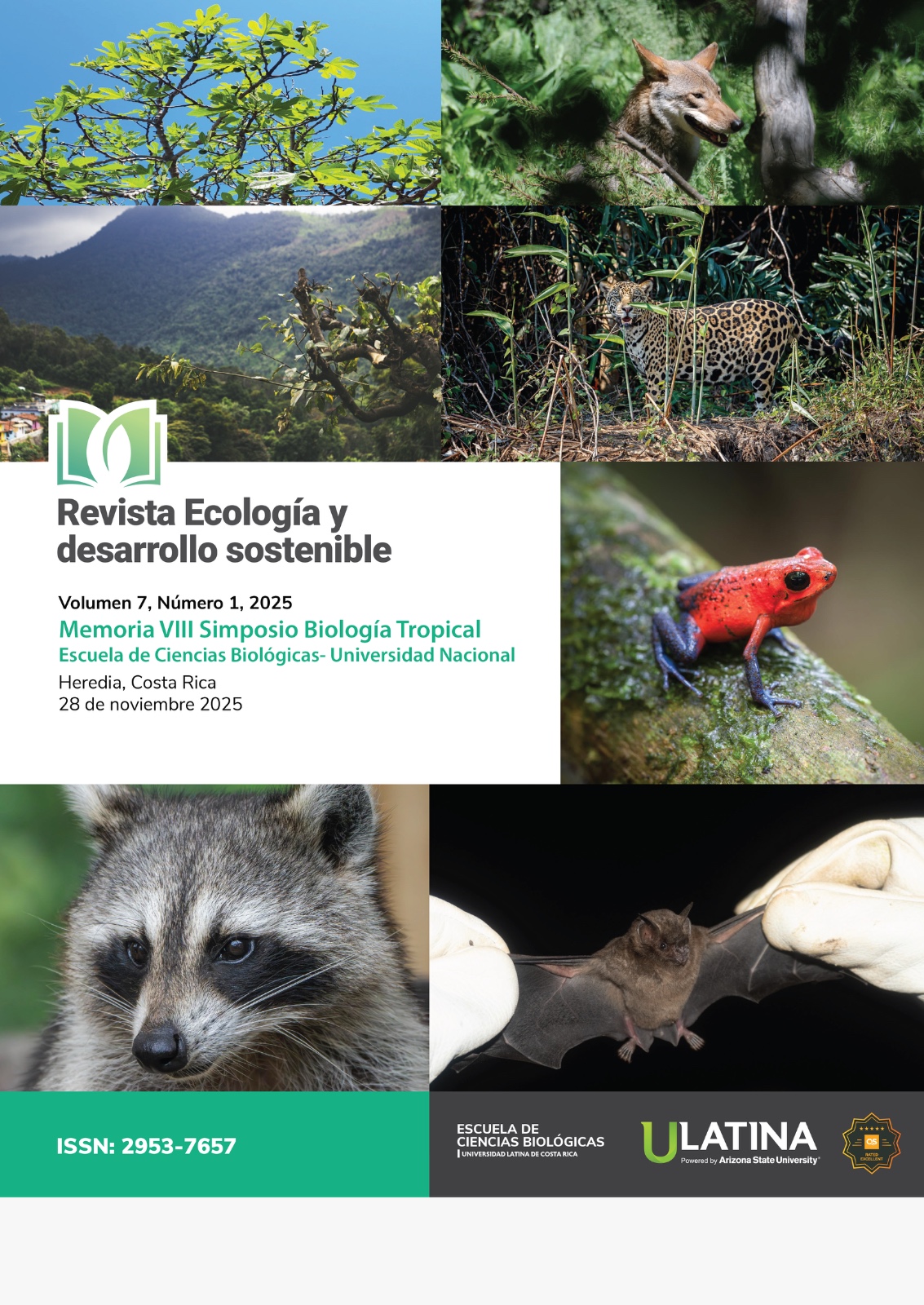Memoria VIII Simposio Biología Tropical 2025
Palabras clave:
comportamiento animal, gestión y educación ambiental, servicios ecosistémicos, participación comunitaria, fisiología vegetal, evaluación del hábitat, restauración ecológica, paleontología biológica, biodiversidad y corredores biológicos interurbanos.Resumen
El lector encontrará en estas páginas los trabajos presentado en el Simposio por parte de estudiantes,
docentes, profesionales, trabajadores y amantes de las ciencias aplicadas, especialmente las biológicas.
Entre las líneas de investigación están las relacionadas con comportamiento animal, gestión y educación
ambiental, servicios ecosistémicos, participación comunitaria, fisiología vegetal, evaluación del
hábitat, restauración ecológica, paleontología biológica, biodiversidad y corredores biológicos interurbanos.
Se presentan resúmenes cortos y largos, además de fotografías de dicha actividad académica.
Descargas
Referencias
Amici, A. A., Nadkarni, N. M., Williams, C. B., &
Gotsch, S. G. (2020). Differences in epiphyte biomass
and community composition along landscape
and within crown spatial scales. Biotropica,
(1), 46–58. https://doi.org/10.1111/btp.12725
Armstrong, R., & Bradwell, T. (2010). Growth of
crustose lichens: a review. Geografiska Annaler:
Series A, Physical Geography, 92(1), 3-17.
Benítez, A., Prieto, M., González, Y., & Aragón, G.
(2012). Effects of tropical montane forest disturbance
on epiphytic macrolichens. The Science
of the Total Environment, 441, 169–175.
https://doi.org/10.1016/j.scitotenv.2012.09.072
Benítez, A., Aragón, G., González, Y., & Prieto, M.
(2018). Functional traits of epiphytic lichens in response
to forest disturbance and as predictors of total
richness and diversity. Ecological Indicators, 86,
–26. https://doi.org/10.1016/j.ecolind.2017.12.021
Benítez, Á., Aragón, G., & Prieto, M. (2019). Lichen
diversity on tree trunks in tropical dry forests
is highly influenced by host tree traits. Biodiversity
and Conservation, 28(11), 2909–2929.
https://doi.org/10.1007/s10531-019-01805-9
Brigham, L. (2016). Distribution of Lichens and Bryophytes
Along an Elevational Gradient in the Monteverde
Cloud Forest, Costa Rica [, University of California, San
Diego, California]. RIS. https://digital.lib.usf.edu/content/
sf/s0/05/60/18/00001/m39-00568-brigham_laurel_lichen_
bryophyte_distribution_eap_spring_2016.pdf
Cordero S., R. A., Garrido, A., Pérez-Molina,
J. P., Ramírez-Alán, O., & Chávez, J. L.
(2021). Lichen community structure and richness
in three mid-elevation secondary forests in
Costa Rica. Revista De Biología Tropical, 69(2),
–699. https://doi.org/10.15517/rbt.v69i2.46162
Rogers, R. W. (1990). Ecological strategies
of lichens. The Lichenologist, 22(2), 149-162.
Sipman, H.J. (2020). Identification key and literature
guide to the genera of Lichenized Fungi (Lichens)
in the Neotropics. Botanic Garden & Botanical
Museum Berlin-Dahlem. https://archive.bgbm.
org/BGBM/ STAFF/Wiss/Sipman/keys/neokeyA.htm
Sipman, H.J., Lücking, R., Aptroot, A., Chaves, J.L.,
Kalb, K., & Tenorio, L.U. (2012). A first assessment
of the Ticolichen biodiversity inventory in Costa Rica
and adjacent areas: the thelotremoid Graphidaceae
(Ascomycota: Ostropales). Phytotaxa, 55(1),
–214. https://doi.org/10.11646/phytotaxa.55.1.1
Waring, B. (2008). Light exposure affects secondary
compound diversity in lichen communities in
Monteverde, Costa Rica [, University of Pennsylvania,
Pennsylvania]. RIS. https://digital.lib.usf.
edu/content/sf/s0/00/12/95/00001/m39-00376-
waring_bonnie_secondary_compound_diversity_
lichen_communities_ciee_spring_2007.pdf
Brousseau, L., Fine, P. V., Dreyer, E., Vendramin,
G. G., y Scotti, I. (2021). Genomic and phenotypic
divergence unveil microgeographic adaptation
in the Amazonian hyperdominant tree Eperua falcata
Aubl.(Fabaceae). Molecular Ecology, 30(5),
-1154.
Cernusak, L. A., Winter, K., Dalling, J. W.,
Holtum, J. A., Jaramillo, C., Körner, C., ... y
Wright, S. J. (2013). Tropical forest responses
to increasing atmospheric CO2: current
knowledge and opportunities for future research.
Functional plant biology, 40(6), 531-551.
Condit, R., Pérez, R. A., y Daguerre,
N. (2010). Trees of Panama and Costa
Rica (Vol. 74). Princeton University Press.
Flores, E.M. 2002. Samanea saman (Jacq).
Merr. In: Vozzo, J. A. Tropical tree seed
manual (No. 721) (pp. 701-704). US Department
of Agriculture, Forest Service.
Hogan, K. P., Smith, A. P., Araus, J. L., y Saavedra,
A. (1994). Ecotypic differentiation of gas exchange
responses and leaf anatomy in a tropical forest
understory shrub from areas of contrasting rainfall
regimes. Tree Physiology, 14(7-8-9), 819-831.
Hussain, S., Ulhassan, Z., Brestic, M., Zivcak,
M., Zhou, W., Allakhverdiev, S. I., ... y Liu, W.
(2021). Photosynthesis research under climate
change. Photosynthesis Research, 150, 5-19.
Makino, A., y Mae, T. (1999). Photosynthesis
and plant growth at elevated levels of CO2.
Plant and Cell Physiology, 40(10), 999-1006.
Peterson, A. G., Ball, T. J., Yiqi, L., Field, C. B., Reich,
P. B., Curtis, P. S., Griffin, K. L., Gunderson,
C. A., Norby, R. J., y Zak, D. R. (1999). The photosynthesis-
leaf nitrogen relationship at ambient
and elevated atmospheric carbon dioxide: A meta-
analysis. Global change biology, 5(3), 331-346.
Sage, R. F., Sharkey, T. D., y Seemann, J. R. (1989).
Acclimation of photosynthesis to elevated CO2 in
five C3 species. Plant Physiology, 89(2), 590-596.
Sharp, R. E., Matthews, M. A., y Boyer, J. S.
(1984). Kok effect and the quantum yield of
photosynthesis: light partially inhibits dark
respiration. Plant physiology, 75(1), 95-101.
Umaña, M. N., Salgado-Negret, B., Norden, N., Salinas,
V., Garzón, F., Medina, S. P., Rodríguez-M,
G. M., López-Camacho, R., Castaño-Naranjo, A.,
Cuadros, H., Franke-Ante, R., Avella, A., Idárraga-
Piedrahita, A., Jurado, R., Nieto, J., Pizano,
C., Torres, A. M., García, H., y González-M, R.
(2023). Upscaling the effect of traits in response
to drought: The relative importance of safety–efficiency
and acquisitive–conservation functional
axes. Ecology Letters, 26(12), 2098-2109.
Yin, X., Niu, Y., van der Putten, P. E., y Struik,
P. C. (2020). The Kok effect revisited.
New Phytologist, 227(6), 1764-1775.
Buchner, L., Eisen, A. K., & Jochner-Oette,
S. (2024). Effects of ash dieback on leaf
physiology and leaf morphology of Fraxinus
excelsior L. Trees, 38(5), 1205-1221.
Hódar, J. A. (2002). Leaf fluctuating asymmetry
of Holm oak in response to drought
under contrasting climatic conditions. Journal
of arid environments, 52(2), 233-243.
Li, Y., Zhang, Y., Liao, P. C., Wang, T., Wang, X.,
Ueno, S., & Du, F. K. (2021). Genetic, geographic,
and climatic factors jointly shape leaf morphology
of an alpine oak, Quercus aquifolioides
Rehder & EH Wilson. Annals
of Forest Science, 78, 1-18.
Venâncio, H., Alves-Silva, E., & Santos, J. C.
(2016). Leaf phenotypic variation and developmental
instability in relation to different light regimes.
Acta Botanica Brasilica, 30, 296-303.
Descargas
Publicado
Versiones
- 2025-03-04 (2)
- 2025-03-03 (1)
Número
Sección
Licencia
Derechos de autor 2025 Ecología y Desarrollo Sostenible

Esta obra está bajo una licencia internacional Creative Commons Atribución-NoComercial-SinDerivadas 4.0.







